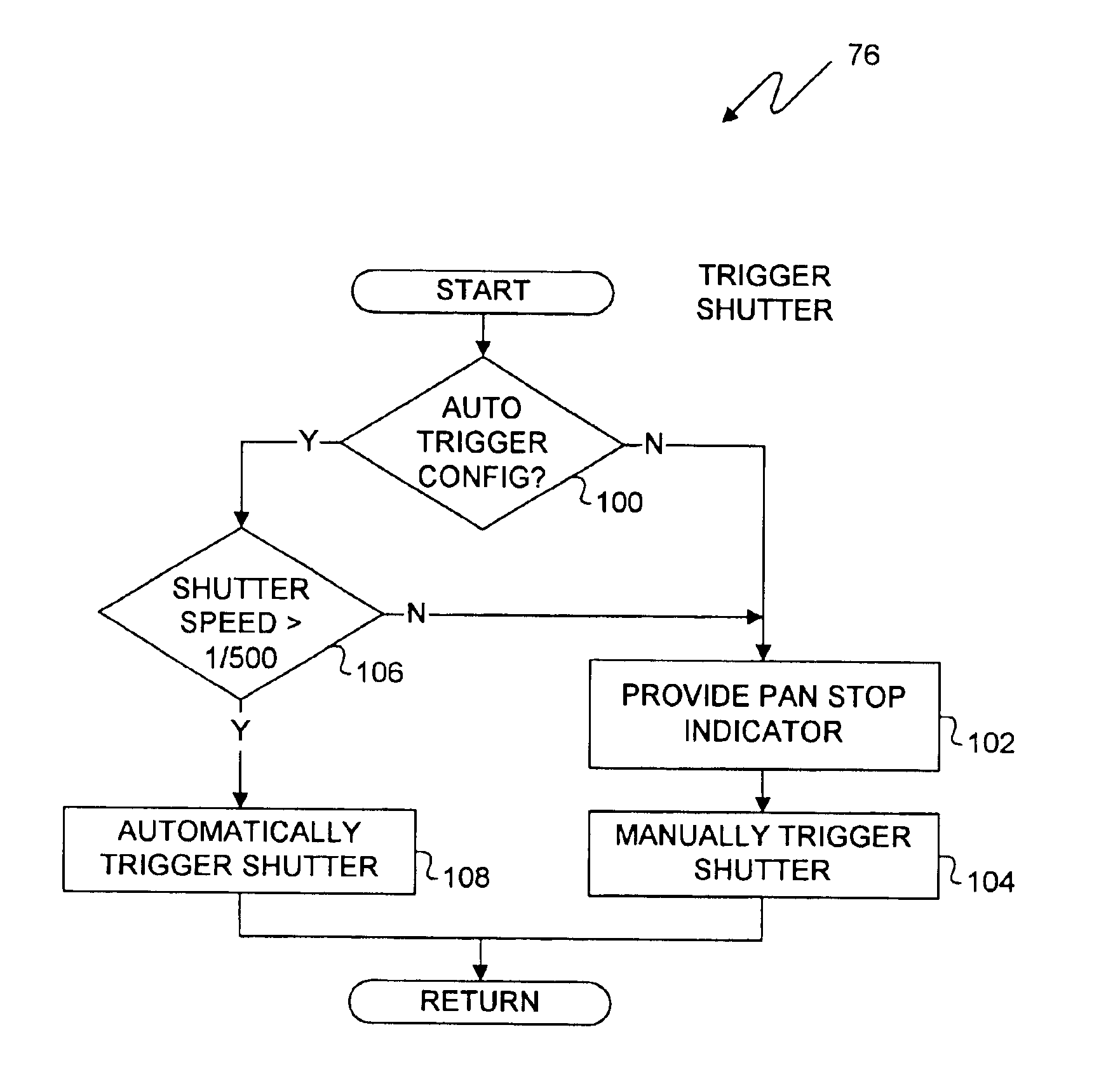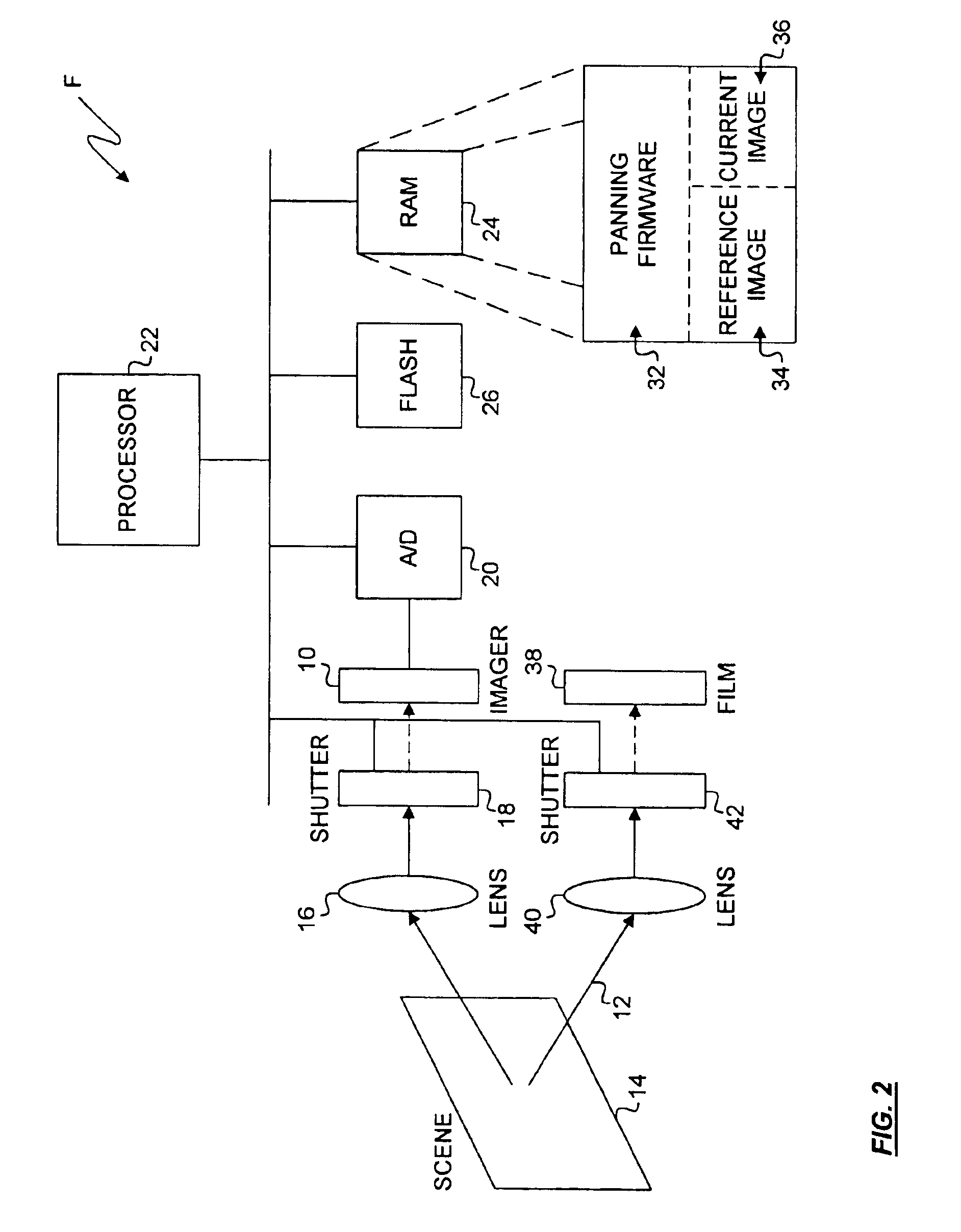Method and apparatus for automatically capturing a plurality of images during a pan
a technology of automatic exposure and pan, which is applied in the field of automatic exposure release of cameras, can solve the problems of inconvenient use of the camera, and inability to automatically capture the plurality of images during the pan,
- Summary
- Abstract
- Description
- Claims
- Application Information
AI Technical Summary
Problems solved by technology
Method used
Image
Examples
first embodiment
[0030]Referring first to FIG. 1, there is illustrated a block diagram of a camera C according to a The invention is embodied in a digital camera having a single processor capable of performing conventional camera operations as well as performing image analysis for purposes of automatically triggering exposures during a pan.
[0031]In contrast to traditional film-based cameras, digital cameras use a solid-state device called an image sensor 10. The image sensor 10 is a fingernail-sized silicon chip containing hundreds of thousands or millions of photosensitive elements in an array. The image sensor 10 is an active-pixel CMOS (complementary metal-oxide semiconductor) type sensor, however, alternative sensors may be used such as, passive-pixel CMOS and charge-coupled device (CCD) sensors.
[0032]In likeness to a traditional camera, light 12 reflected from a scene 14 enters the camera C through a lens 16 controlled by a shutter 18. The lens 16 focuses the scene 14 on the image sensor 10 an...
second embodiment
[0040]Now referring to FIG. 2, there is illustrated a camera F according to the present invention. It is noted that the components repeated from FIG. 1 are substantially identical and no further explanation is needed except as provided below. The first alternative embodiment relates to a film-based camera F having digital image processing capabilities to automatically trigger exposures during a pan.
[0041]In contrast to the digital cameras, the film-based camera F uses conventional silver halide-based film 38 to capture exposures. Light 12 reflected from the scene 14 enters the camera F through a lens 40 controlled by an electromechanical shutter 42. The shutter 42 is electronically triggered as a result of the pan image capture routine 32 executed by the processor 22.
[0042]As described in FIG. 1, the pan image capture routine 32 is responsive to digital images acquired via the imager 10. However, in this embodiment the acquired digital images are preferably not stored in a persisten...
third embodiment
[0044]Now referring to FIG. 3, there is illustrated a camera M according to the present invention. It is noted that the components repeated from FIG. 1 are substantially identical and no further explanation is needed except as provided below.
[0045]This embodiment relates to a digital or film-based (not illustrated) camera M having an auxiliary navigation sensor 44. The navigation sensor 44 tracks movement of the camera as it is panned across the scene 14. In one embodiment, the navigation sensor 44 is an image sensor and processing device having an array of photosensitive elements to track movement of the scene as the camera M is panned. The image sensor and processing device performs a series of nearest neighbor cross-correlations between a previously stored image and a most recently acquired image to determine relative displacement. Since this embodiment uses light reflected from scene 14, it will have an independent optical path as compared to the main light path (as shown in FIG...
PUM
 Login to View More
Login to View More Abstract
Description
Claims
Application Information
 Login to View More
Login to View More - R&D
- Intellectual Property
- Life Sciences
- Materials
- Tech Scout
- Unparalleled Data Quality
- Higher Quality Content
- 60% Fewer Hallucinations
Browse by: Latest US Patents, China's latest patents, Technical Efficacy Thesaurus, Application Domain, Technology Topic, Popular Technical Reports.
© 2025 PatSnap. All rights reserved.Legal|Privacy policy|Modern Slavery Act Transparency Statement|Sitemap|About US| Contact US: help@patsnap.com



